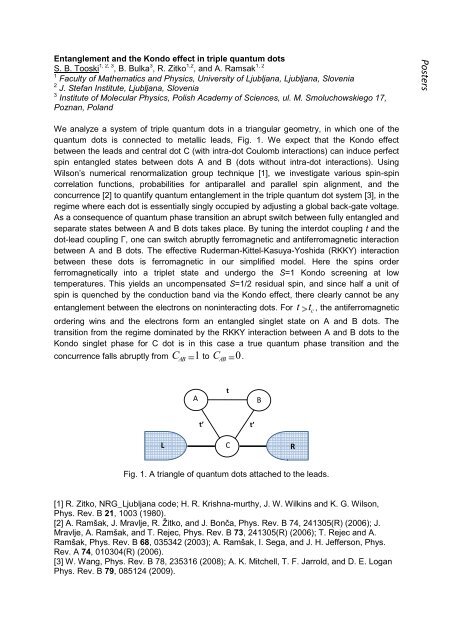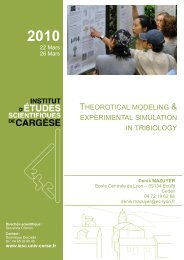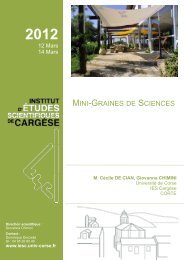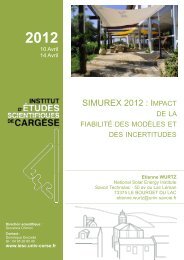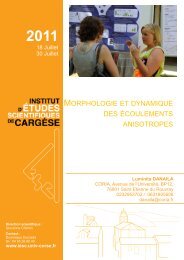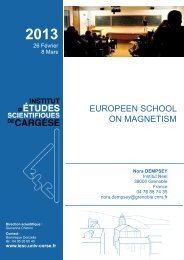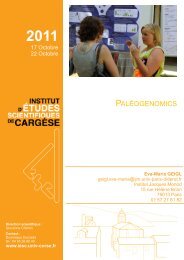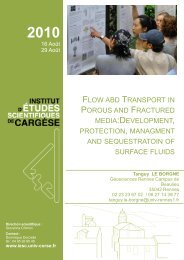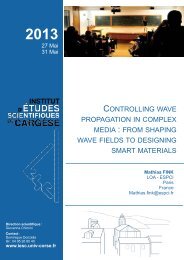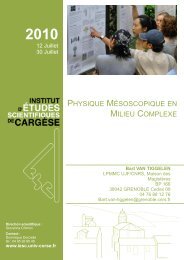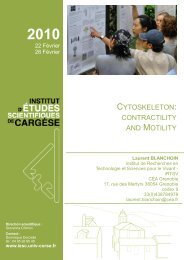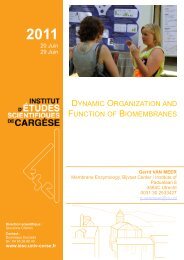nanoelectronics - Institut d'Études Scientifiques de Cargèse (IESC)
nanoelectronics - Institut d'Études Scientifiques de Cargèse (IESC)
nanoelectronics - Institut d'Études Scientifiques de Cargèse (IESC)
Create successful ePaper yourself
Turn your PDF publications into a flip-book with our unique Google optimized e-Paper software.
Posters<br />
Entanglement and the Kondo effect in triple quantum dots<br />
S. B. Tooski 1, 2, 3 , B. Bulka 3 , R. Zitko 1,2 , and A. Ramsak 1, 2<br />
1 Faculty of Mathematics and Physics, University of Ljubljana, Ljubljana, Slovenia<br />
2 J. Stefan <strong>Institut</strong>e, Ljubljana, Slovenia<br />
3 <strong>Institut</strong>e of Molecular Physics, Polish Aca<strong>de</strong>my of Sciences, ul. M. Smoluchowskiego 17,<br />
Poznan, Poland<br />
We analyze a system of triple quantum dots in a triangular geometry, in which one of the<br />
quantum dots is connected to metallic leads, Fig. 1. We expect that the Kondo effect<br />
between the leads and central dot C (with intra-dot Coulomb interactions) can induce perfect<br />
spin entangled states between dots A and B (dots without intra-dot interactions). Using<br />
Wilson’s numerical renormalization group technique [1], we investigate various spin-spin<br />
correlation functions, probabilities for antiparallel and parallel spin alignment, and the<br />
concurrence [2] to quantify quantum entanglement in the triple quantum dot system [3], in the<br />
regime where each dot is essentially singly occupied by adjusting a global back-gate voltage.<br />
As a consequence of quantum phase transition an abrupt switch between fully entangled and<br />
separate states between A and B dots takes place. By tuning the interdot coupling t and the<br />
dot-lead coupling Γ, one can switch abruptly ferromagnetic and antiferromagnetic interaction<br />
between A and B dots. The effective Ru<strong>de</strong>rman-Kittel-Kasuya-Yoshida (RKKY) interaction<br />
between these dots is ferromagnetic in our simplified mo<strong>de</strong>l. Here the spins or<strong>de</strong>r<br />
ferromagnetically into a triplet state and un<strong>de</strong>rgo the S=1 Kondo screening at low<br />
temperatures. This yields an uncompensated S=1/2 residual spin, and since half a unit of<br />
spin is quenched by the conduction band via the Kondo effect, there clearly cannot be any<br />
entanglement between the electrons on noninteracting dots. For t t , the antiferromagnetic<br />
or<strong>de</strong>ring wins and the electrons form an entangled singlet state on A and B dots. The<br />
transition from the regime dominated by the RKKY interaction between A and B dots to the<br />
Kondo singlet phase for C dot is in this case a true quantum phase transition and the<br />
concurrence falls abruptly from C AB 1 to C AB 0.<br />
c<br />
A<br />
t<br />
B<br />
t’ t’<br />
L<br />
C<br />
R<br />
Fig. 1. A triangle of quantum dots attached to the leads.<br />
[1] R. Zitko, NRG_Ljubljana co<strong>de</strong>; H. R. Krishna-murthy, J. W. Wilkins and K. G. Wilson,<br />
Phys. Rev. B 21, 1003 (1980).<br />
[2] A. Ramšak, J. Mravlje, R. Žitko, and J. Bonča, Phys. Rev. B 74, 241305(R) (2006); J.<br />
Mravlje, A. Ramšak, and T. Rejec, Phys. Rev. B 73, 241305(R) (2006); T. Rejec and A.<br />
Ramšak, Phys. Rev. B 68, 035342 (2003); A. Ramšak, I. Sega, and J. H. Jefferson, Phys.<br />
Rev. A 74, 010304(R) (2006).<br />
[3] W. Wang, Phys. Rev. B 78, 235316 (2008); A. K. Mitchell, T. F. Jarrold, and D. E. Logan<br />
Phys. Rev. B 79, 085124 (2009).


